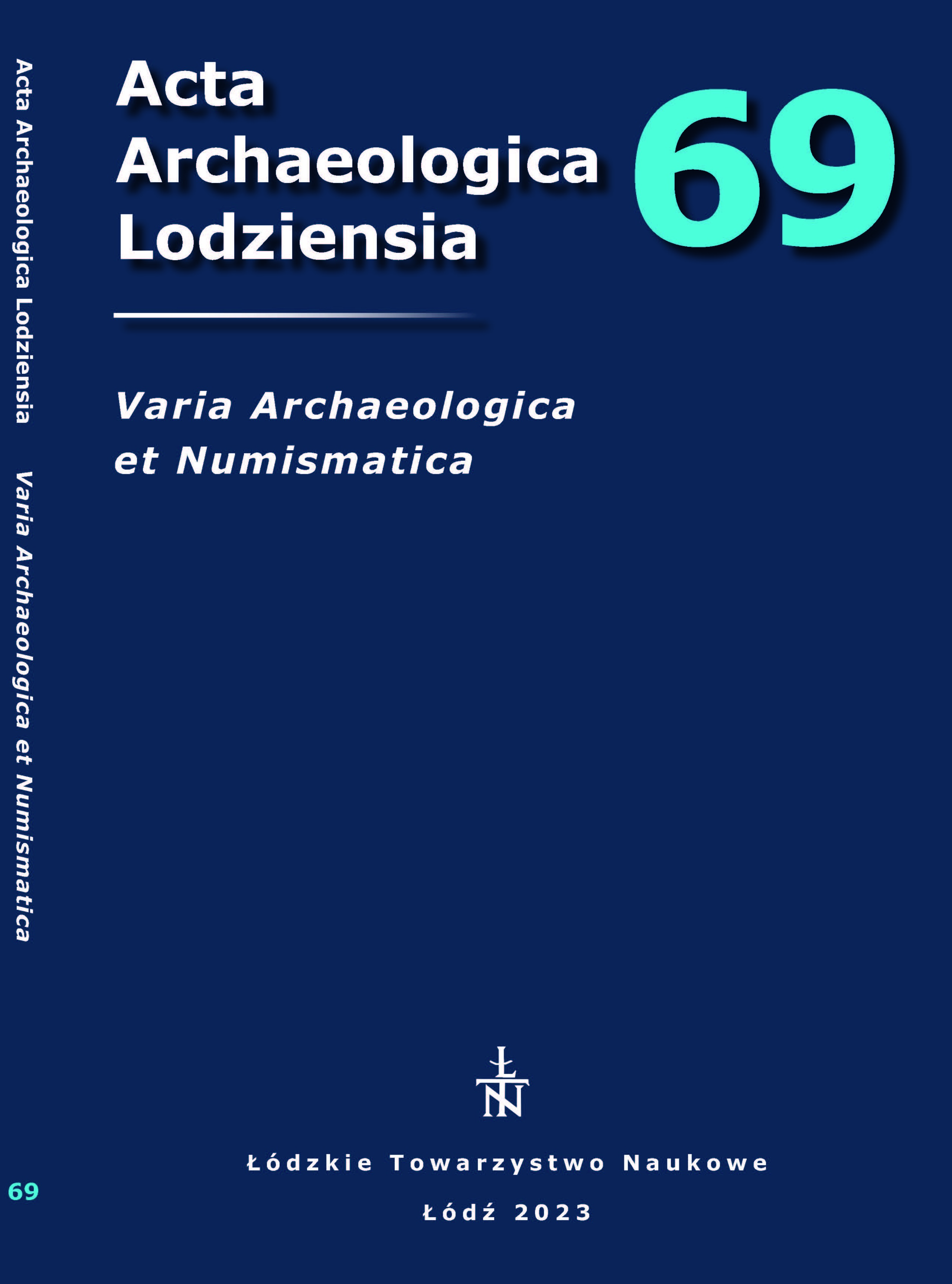The straw, the brick, and the metaphor: in the narratives in the Book of Exodus
DOI:
https://doi.org/10.26485/AAL/2023/69/3Słowa kluczowe:
mud-brick, metaphor, Israelites in EgyptAbstrakt
Cegła mułowa stosowana powszechnie w architekturze Egiptu stała się jednym z symboli ciężkiej pracy Izraelitów w starożytnym Egipcie, przyjmując metaforyczną symbolikę w narracji biblijnej, relacjonującej wydarzenia związane z Eksodusem. Poniższy tekst odnosi się właśnie do tej kategorii materiału budowlanego i jego metaforycznego znaczenia.
Bibliografia
Asman J. 2014. From Akhenaten to Moses: Ancient Egypt and religious change, Cairo‒New York.
Assman J. 2015. Exodus and Memory. In T.E. Levy, T. Schneider, W.H.C. Propp (eds.), Israel’s Exodus in transdisciplinary perspective. Text, archaeology, culture and geoscience, Cham‒ Heidelberg‒New York‒Dordrecht‒London, 3-15.
Bietak M., Rensburg G. 2021. Egypt and the Exodus, Chapter II. In Hershel Shanks and John Merrill (eds.), Ancient Israel, From Abraham to the Roman Destruction of the Temple, Revised and Expanded Edition, Washington, Biblical Archaeology Society, 17-58: 342-351.
Davies G. de N. 1943. The tomb of Rekhmi-Re at Thebes, New York.
Falk A.D. 2020. Brick by Brick: What Did the Israelites Build in Egypt? BAR, Spring, 54-57.
Finkelstein I., Silberman A.N. 2002. The Bible Unearthed: Archaeology’s New Vision of Ancient Israel and the Origin of Its Sacred Text, New York.
Grimal N. 2004. Dzieje starożytnego Egiptu, przeł. A. Łukaszewicz, Warszawa.
Halpern B. 1993. The Exodus and the Israelite Historians, Erez Israel 24: Abraham Malamat Volume: 89-96.
Hoffmeier K.J. 1999. Israel in Egypt. The Evidence for the Authenticity of the Exodus Tradition, New York.
Hoffmeier K.J. 2005. Ancient Israel in Sinai: The Evidence for the authenticity of the wilderness tradition, Oxford.
Hoffmeier K.J. 2012. Out of Egypt, The Archaeological Context of the Exodus.
Hoffmeier K.J. 2014. The Exodus and Wilderness Narratives. In Bill T. Arnold, R.S. Hess (eds.), Ancient Israel’s History. An Introduction to Issues and Sources, Grand Rapides: 46-90.
Kemp J.B. 2009. Soil (Including mud-brick architecture). In P.T. Nicholson, I. Shaw, Ancient Materials and Technology, Cambridge, 78-103.
Kemp J.B. 2009a. Starożytny Egipt, Anatomia Cywilizacji (tłumacz. J. Akami), Warszawa.
Kemp J.B. 2018. Ancient Egypt: Anatomy of a Civilization (3rd ed.), New York.
Kitchen K. 1976. From the Brickfields of Egypt, Tynkale Bulletin 27: 137-147.
Kitchen K. 2003. On the Reliability of the Old Testament, Cambridge‒Eerdmans.
Koehler L., Baumgartner W. 2001. The Hebrew and Aramaic Lexicon of the Old Testament (Study Edition). Leiden‒Brill.
Lemański J. 2014. Exodus – pomiędzy historią, mitem i koncepcją teologiczną, The Biblical Annals 4/2, 279-311.
LeMon M.J. 2022. Egipt i Egipcjanie. In B.T. Arnold, B.A. Strawn (eds.), Sąsiedzi starożytnego Izraela, tł. Z. Kościuk, Warszawa, 223-255.
Littman R., Lorenzon M., Silverstein J. 2014. With & Without Straw: How Israelite Slaves Made Bricks, Biblical Archaeology Review 40:2, March/April: 60-71.
Liverani M. 2010. Nie tylko Biblia. Historia staro¬żytnego Izraela, przekł. J. Puchalski, Warszawa.
Łukaszeiwcz A. 2021, W słońcu Egiptu: Z dziejów podróży nad Nil, Warszawa.
Łukaszewicz A. 2007. Jan Potocki i początki Egiptologii, Meander 3-4, 62: 308-328.
Mélèze-Modrzejewski J. 2000. Żydzi nad Nilem: od Ramzesa II do Hadriana (Biblioteka Zwojów, Tło Nowego Testamentu 3), przeł. J. Olkiewicz, Kraków.
Miller Maxwell J., Hayes H.J. 1986. A History of Ancient Israel, and Judah, Philadelphia‒Westminster.
Murray A.M. 2009. Cereal production and processing. In P.T. Nicholson, I. Shaw, Ancient Materials and Technology, Cambridge, 505-536.
Nims F.Ch. 1950. Bricks without Straw? The Biblical Archaeologist 13, 2: 21-28.
Ormeling M. 2016. Modelling labour in ancient Egypt: The First dynasty Mud brick Fortress at Elephantine.
Packer, I.J., Tenney C.M. (eds.) 2007. Słownik tła Biblii, tł. Z. Kościuk, Warszawa.
Petrovitch D. 2006. Amenhotep II, and the historicity of the Exodus-pharaoh, TMSJ17/1 (Spring 2006): 81-110.
Raspe L. 1998. Manetho on the Exodus: A Reappraisal, Jewish Studies Quarterly, 5, No. 2: 124-155.
Redford B.D. 1963. Exodus I 11, Vetus Testamentum 13, 4: 401-418.
Redford B.D. 1993. Egypt, Canaan, and Israel in Ancient Times, Princeton.
Ronny R. 1992. Building Materials and Architectural Elements in Ancient Israel, in The Architecture of Ancient Israel. Eds. A. Kempinski and R. Reich. Jerusalem: Israel Exploration Society: 1-16.
Sarna M.N. 1986. Exploring Exodus: The Oppression Source, The Biblical Archaeologist 49, 2: 68-80.
Sarna M.N. 1996. Exploring Exodus: The Origins of Biblical Israel, New York.
Sarna M.N., Shanks H. 2007. Izrael w Egipcie. Pobyt w Egipcie i wyjście. In H. Shanks (ed.), Starożytny Izrael, przeł. W. Chrostowski, Warszawa, 69-98.
Schlögl A.H. 2009. Starożytny Egipt, Historia i kultura od czasów najdawniejszych do Kleopatry, tłum. A. Gadzała, Warszawa.
Tompsett D. 2023. Ancient Israel in Egypt, Through a Glass, Darkly, Eugene.
Walton H.J., Matthews H.V. 1997. The IVP Bible Background Commentary: Genesis- Deuteronomy (Downers Grove).
Wilkinson T. 2011. Powstanie i upadek Starożytnego Egiptu, Dzieje cywilizacji od 3000 p.n.e. do czasów Kleopatry, przeł. N. Radomski, Poznań.
Pobrania
Opublikowane
Jak cytować
Numer
Dział
Licencja
Prawa autorskie (c) 2024 Łódzkie Towarzystwo Naukowe

Utwór dostępny jest na licencji Creative Commons Uznanie autorstwa – Użycie niekomercyjne – Bez utworów zależnych 4.0 Międzynarodowe.



